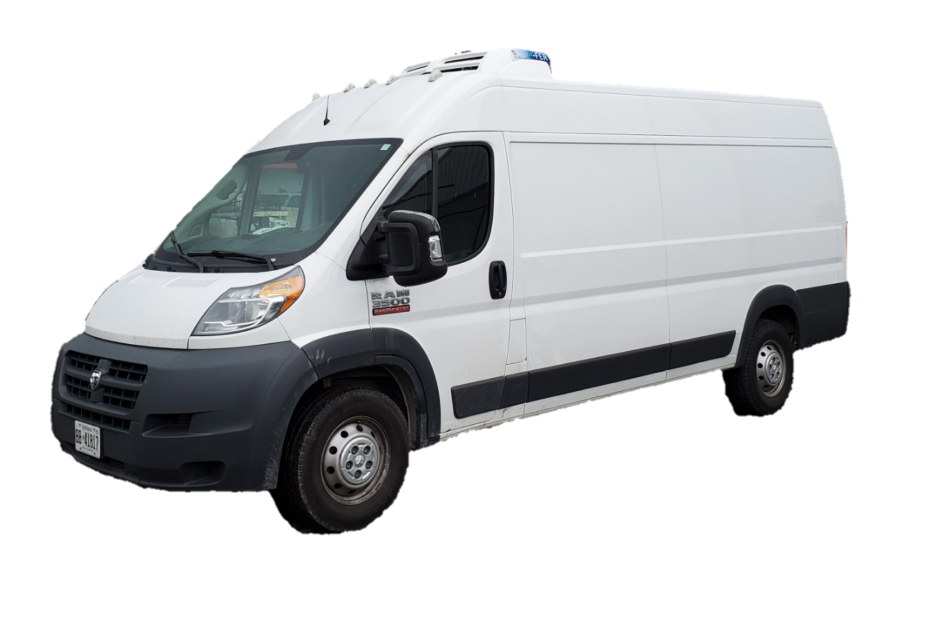Reefer Systems Create Cold, Right?
One of the most common misconceptions we hear, is that transport refrigeration units (TRU’s) used in vehicles such as a refrigerated vans, trucks, reefer trailers and cooler trailers can actually create cold. This is certainly not the case. Although it may feel cold within a refrigerated container, a refrigeration unit works by actually removing heat, too lower the temperature. By removing even more heat, you can achieve extremely low temperatures.
If you were to remove a frozen steak from your freezer and place it on your counter, it would begin to de-thaw by absorbing the surrounding heat. Refrigerated transport systems work to remove heat from the refrigerated van, truck or trailer to achieve the correct temperature before the cold product is loaded.
The refrigerated transport unit then works to maintain the desired temperature required. Most refrigeration systems tend to work in the same way and consist of four main parts. An evaporator, condenser, expansion valve and compressor all work together to remove heat from the refrigerated compartment.
The refrigeration cycle, is basically a fluid, passing around a length of pipe that runs between the above mention four main components. A liquid refrigerant is used, to collect heat from one area, and then dump it somewhere else. There are four main stages in the refrigeration cycle, where the temperature and the pressure change.
The 1st Stage
The first stage, happens at the compressor. The refrigerant enters the compressor as a low pressure warm gas, and after it’s compressed, it leaves the compressor as a high pressure hot gas. When you compress a fluid the volume decreases, the molecules are compressed close together. This causes the temperature to rise, which increases the pipe temperature. That’s important, because the ambient temperature has to be lower than the pipe in order for the heat to be ejected at the condenser.
The 2nd Stage
Speaking of the condenser, that brings us to the 2nd stage of the refrigeration cycle. The refrigerant enters the condenser as a high pressure, hot gas where it passes through the condenser coils. The outside air is drawn over the condenser coils by the fan, causing the heat to dissipate and the refrigerant loses its temperature (Ever wonder what the fins are for on the condenser and evaporator? They are attached to the tubes, and allow the heat to dissipate by creating a larger surface area for the air to pass over, taking the heat away into the ambient outside air). As the refrigerant cools down, it begins to condense (hence the name condenser) and turns from a gas to a liquid. The fluid leaves the condenser as a high pressure, regular temperature liquid.
The 3rd Stage
Stage 3 happens at the expansion valve. The expansion valve regulates the flow of refrigerant around the system. It does this by using a diaphragm. It’s connected to a thermal bulb attached near the exit of the evaporator by a capillary tube. Depending on the temperature of the refrigerant leaving the evaporator, the refrigerant in the thermal bulb will expand or contract. This pressure change travels through the capillary tube to the diaphragm in the expansion valve, moving the diaphragm up and down. That up and down movement of the diaphragm, will allow more or less refrigerant through the expansion valve. Because the valve restricts the flow of refrigerant, there will be less refrigerant on the other side of the expansion valve. This will allow the molecules of the refrigerant to expand, causing the temperature and pressure of the refrigerant to lower, leaving the expansion valve as a low pressure, cold liquid.
The 4th Stage
So that brings us to stage 4, and final stage of the refrigeration cycle. The refrigerant enters the evaporator as a low pressure cold liquid and passes through the coil, which is very similar to the process in the condenser. On the other side of the pipe, is the air in the refrigerated van or container that needs to be cooled. An evaporator fan pulls that air over the evaporator coil and fins. As that air travels across the evaporator, it transfers the cold from fins and coil and circulates that air through the reefer van. When this happens it allows the refrigerant to pick up the warmer air and transfer it to the condenser to be cooled. As the refrigerant passes through the evaporator, it begins to boil and it will evaporate (hence the name evaporator) from a liquid, to a gas. It does this, because the boiling point of refrigerant is very low. R134A for example, has a boiling point of -23 degrees, so it doesn’t take much for that refrigerant to become a low pressure warm gas as it travels through the evaporator. This low pressure warm gas then gets sucked into the compressor where the cycle begins again.
Find Out How We Can Help With Your Refrigerated Van Needs
If you are shipping refrigerated products via a reefer van or refrigerated truck, then you need to be able to trust that the refrigerated vehicle builder is an expert. As a fleet management company that specializes in regional fleets and refrigerated units, Glen Ridge Fleet Inc. is that expert. We have a unique knowledge when it comes to building refrigerated fleets, because we look to achieve a maximum ROI for the assets of our fleet management customers.If your company requires fleet management services, contact Glen Ridge Fleet today. We offer a Total Fleet Management Program to help you and your company with the ongoing management and optimization of your fleet. Contact us for more information on how your company can benefit from outsourcing your fleet management needs.
